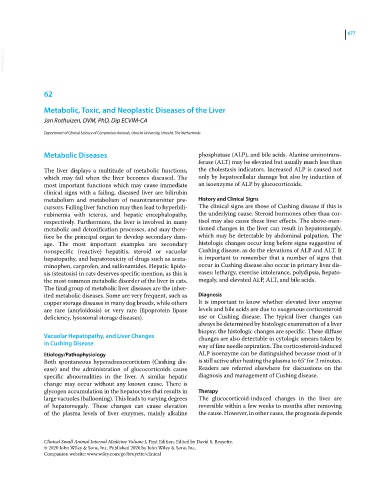Page 709 - Clinical Small Animal Internal Medicine
P. 709
677
VetBooks.ir
62
Metabolic, Toxic, and Neoplastic Diseases of the Liver
Jan Rothuizen, DVM, PhD, Dip ECVIM-CA
Department of Clinical Science of Companion Animals, Utrecht University, Utrecht, The Netherlands
Metabolic Diseases phosphatase (ALP), and bile acids. Alanine aminotrans-
ferase (ALT) may be elevated but usually much less than
The liver displays a multitude of metabolic functions, the cholestasis indicators. Increased ALP is caused not
which may fail when the liver becomes diseased. The only by hepatocellular damage but also by induction of
most important functions which may cause immediate an isoenzyme of ALP by glucocorticoids.
clinical signs with a failing, diseased liver are bilirubin
metabolism and metabolism of neurotransmitter pre- History and Clinical Signs
cursors. Failing liver function may then lead to hyperbili- The clinical signs are those of Cushing disease if this is
rubinemia with icterus, and hepatic encephalopathy, the underlying cause. Steroid hormones other than cor-
respectively. Furthermore, the liver is involved in many tisol may also cause these liver effects. The above‐men-
metabolic and detoxification processes, and may there- tioned changes in the liver can result in hepatomegaly,
fore be the principal organ to develop secondary dam- which may be detectable by abdominal palpation. The
age. The most important examples are secondary histologic changes occur long before signs suggestive of
nonspecific (reactive) hepatitis, steroid or vacuolar Cushing disease, as do the elevations of ALP and ALT. It
hepatopathy, and hepatotoxicity of drugs such as aceta- is important to remember that a number of signs that
minophen, carprofen, and sulfonamides. Hepatic lipido- occur in Cushing disease also occur in primary liver dis-
sis (steatosis) in cats deserves specific mention, as this is eases: lethargy, exercise intolerance, polydipsia, hepato-
the most common metabolic disorder of the liver in cats. megaly, and elevated ALP, ALT, and bile acids.
The final group of metabolic liver diseases are the inher-
ited metabolic diseases. Some are very frequent, such as Diagnosis
copper storage diseases in many dog breeds, while others It is important to know whether elevated liver enzyme
are rare (amyloidosis) or very rare (lipoprotein lipase levels and bile acids are due to exogenous corticosteroid
deficiency, lysosomal storage diseases). use or Cushing disease. The typical liver changes can
always be determined by histologic examination of a liver
biopsy; the histologic changes are specific. These diffuse
Vacuolar Hepatopathy, and Liver Changes changes are also detectable in cytologic smears taken by
in Cushing Disease way of fine needle aspiration. The corticosteroid‐induced
Etiology/Pathophysiology ALP isoenzyme can be distinguished because most of it
Both spontaneous hyperadrenocorticism (Cushing dis- is still active after heating the plasma to 65° for 2 minutes.
ease) and the administration of glucocorticoids cause Readers are referred elsewhere for discussions on the
specific abnormalities in the liver. A similar hepatic diagnosis and management of Cushing disease.
change may occur without any known cause. There is
glycogen accumulation in the hepatocytes that results in Therapy
large vacuoles (ballooning). This leads to varying degrees The glucocorticoid‐induced changes in the liver are
of hepatomegaly. These changes can cause elevation reversible within a few weeks to months after removing
of the plasma levels of liver enzymes, mainly alkaline the cause. However, in other cases, the prognosis depends
Clinical Small Animal Internal Medicine Volume I, First Edition. Edited by David S. Bruyette.
© 2020 John Wiley & Sons, Inc. Published 2020 by John Wiley & Sons, Inc.
Companion website: www.wiley.com/go/bruyette/clinical

